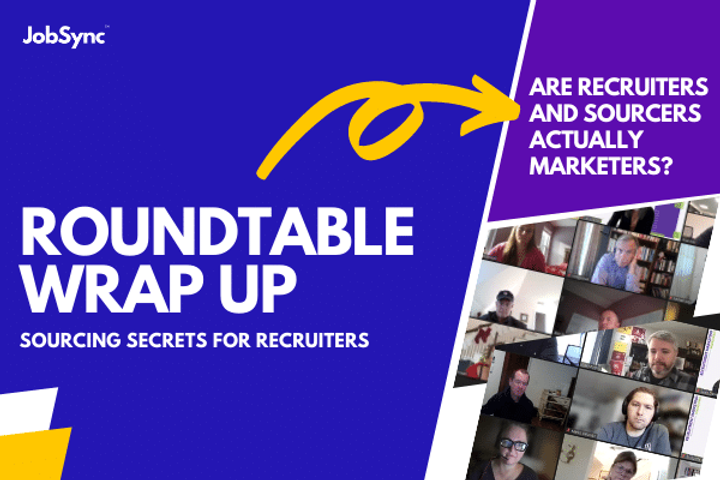
It’s not just the pundits talking, recruiters have leaned into being marketers!
We’re noticing a trend during our roundtables; talent acquisition pros are thinking and acting with a marketing perspective. Think about it. Top of funnel recruiting and sourcing is really lead generation. The goal is to connect with candidates and make your job [and organization] attractive enough to get them to apply. Gone are the days of focusing solely on your tech stack to attract candidates and build great teams. Nowadays you need to build great tech, process, and people stacks.
It’s time to step up your game and set yourself apart from other recruiters and sourcers.
So, once again, we turned the mute buttons off, put the cameras on, and hundreds of forward thinking recruitment professionals joined us to put forth their recruitment marketing chops on best practices to reach and engage candidates at scale, led by Greg Hawkes of M&T Bank and Recruiting IRL. [Watch the full replay here.]
Here are the top 5 ways to use a sourcing mentality (lead gen mentality) when recruiting and engaging candidates.
1. Understand the candidate’s story.
Is the candidate on a work visa? Are they looking to relocate? Do they have young children and need to work remotely or have a schedule that permits them to seek childcare? Whatever the situation may be, understanding what your candidates priorities are can help turn them from a candidate into an applicant into a team member in no time.
“Connect with the candidate on why the opportunity you have will be best for them or how you can connect with that candidate and their wants/needs.” – Bridgette Fitch
This means you have to personalize. Generic blast emails (spray and pray, or, spray and pay) fail. To connect with your candidates, you need to tap into what matters to them, what makes them tick, what they need to say yes to the next step.
But really, we need to get some of the basics right. Use their name. Recognize where they are at now – current role or company. This can be managed at scale, but in a thoughtful way.
2. Set expectations – people want to know what their day to day will look like in a role.
Oh those pesky expectations. For candidates, it’s more than understanding the process of the interview, it’s understanding the process of the job themselves. Without delving into the role, its like selling a solution where you only talk about next steps in the sales process. Recruiting teams have focused on setting expectations of the interview process at the expense of setting expectations to ensure the role is right for the candidate, not just that the candidate is right for the role.
Without Number 1 (above) you will fail at Number 2.
3. Don’t lose scope of your audience.
We asked what one of the biggest challenges is that recruiters face during their outreach and most said they can’t get candidates to respond. If you can’t create a connection within your first or second attempts at outreach you might have lost them.
“We need to remember that the candidates are not us. Just because we want to be communicated with in certain ways, certain numbers of times, certain cadence means nothing as we’re not trying to reach ourselves.” – Steven Rothberg
Personalization is more than just the candidate’s name and location – it’s everything from the time of day that they are able to communicate to the medium in which they prefer. To know your candidate is to adapt to their style that lets them be both the best version of their interviewing self and their future employee self.
4. Be human in your messaging.
What’s a good way to connect? Use your personality! Greg likes to use Dad jokes in his outreach. Use what you got! Being human isn’t just about hyper personalization, it’s about making you as relatable as you are seeing the candidates. Finding those common threads that allow you to connect on emotional levels, where the candidate says, “oh they get me, and I get them.”
“People can tell when it’s a generic message. They want to know that they matter and are not just a number.” – Jenn Post
The goal is not to be pixel perfect, ridgid and right. The goal is for the candidate to immediately know that you are relatable and relating to them.
5. Have a solid company story.
Candidates leave bad bosses and go to good companies. They invest in working for your company – your company values, your company mission, and the opportunities the job itself presents. They don’t come to work for you, the recruiter.
Having a crisp story on who you are as a company and why your employees love being part of your business and your business’ mission is key to getting candidates excited to become your next employees.

